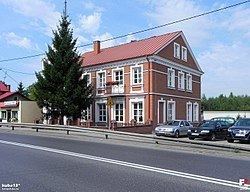City rights 1442–1870 Elevation 157 m Local time Sunday 7:57 AM | Established probably 12th century Time zone CET (UTC+1) Area 11.33 km² | |
 | ||
Weather 3°C, Wind W at 31 km/h, 73% Humidity | ||
Kurów [ˈkuruf] is a village in south-eastern Poland, located in the historic province of Lesser Poland, between Puławy and Lublin, on the Kurówka River. It is capital of a separate gmina (municipality) called Gmina Kurów, within Lublin Voivodeship. The village has 2,817 inhabitants (as of 2015).
Contents
- Map of KurC3B3w Poland
- History
- Jews in Kurw
- Old buildings and places
- Transport
- Sport clubs
- Famous people
- References
Map of Kur%C3%B3w, Poland
History
Kurów was probably firstly mentioned in the Gesta principum Polonorum of Gall Anonim as castrum Galli, what is interpreted as the Castle of the Kurowie. The earliest historical mention of Kurów comes from a document issued in 1185, which mentions a church dedicated to Saint Giles already existing in the place. Sometime between 1431 and 1442 the village was granted city rights based on the Magdeburg Law. As a private town, it was the centre for the trade in food from the surrounding area. Several fur and leather factories were also located here. In the 16th century, Kurów was one of the centres of Calvinism, since many of the Polish Brethren settled there. By 1660, most of the inhabitants had converted to Arianism. At that time, Kurów was one of the most important urban centers of Lublin Voivodeship, one of three voivodeships of historic Lesser Poland.
After 1660, the town shares its history with the rest of the region. In 1795, after the third partition of Poland, Kurów was annexed by Austria. In 1809, it became part of the Duchy of Warsaw. In 1815, Kurów became part of the Kingdom of Poland. During the November Uprising, in February 1831, the minor Battle of Kurów took place, when the Polish forces under general Józef Dwernicki defeated a Russian army. In 1870, a few years after the January Uprising, the town finally lost its city charter, which has not yet been regained. Since 1918, Kurów was once more part of Poland.
On September 9, 1939, during the Polish Defensive War, which is the name in Poland for the start of World War II, the town was heavily bombed by the German Luftwaffe. Among the targets destroyed was a civilian hospital (marked with red crosses), where many victims perished. During World War II, Germany set up two slave labour camps in the town. In 1942, a minor ghetto was established. However, most of the Poles imprisoned in Kurów escaped and joined the Polish Home Army units operating from the nearby forests.
Jews in Kurów
Almost 2000 Jews lived in Kurów when the Second World War began. The Jewish population of Kurów came to end with the war and the slaughter that ensued. The Germans bombed the synagogue, from the air, they machine gunned the people fleeing the bombing. The Jews attempted to set up their lives to live under the domination of the German regime but there was no way to accommodate it. Many of the Jews ran to the forests and attempted to take shelter there but the Polish partisans killed them for any reason; for their shoes, for their weapons or just because they were Jews. Many times, the Polish population helped the Jews, even rising own life. Thanks to Mieczysław Kutnik, Adam Turczyk or Wacław Mańko several Jews survived the war. A greater portion of the Jewish population were transported to Sobibor where they were murdered outright. Just a few of the Kurów Jews managed to survive the selections of the first days in that camp and those Jews were able to help organize and execute the revolt in Sobibor which resulted in the destruction of the camp by the Germans themselves. A number of Jewish Kurovites were decorated by the Russians for their valor as partisans during the war.
Those who were successful were hiding in Garbów forests, where a Jewish partisan unit was active, headed by Kaim Elizer Wurman.
Many former Jewish residents of Kurów emigrated to America, Israel, Argentina, France before World War II and other points elsewhere, wherever they could find refuge. There was a Kurów burial society in New York.
Old buildings and places
Transport
The S12 and S17 expressways run through the north of Kurów since 2013, allowing Lublin–Warsaw traffic to bypass the village. The busy national road DK12 (Łęknica–Dorohusk) runs through the middle of Kurów.
